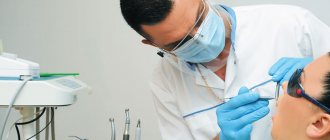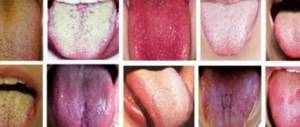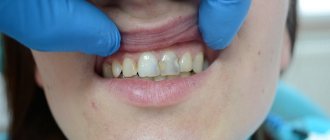Alveolitis of a tooth is a dental disease that is characterized by infection and inflammation of its alveoli after extraction. It is manifested by moderate or intense pain symptoms, a feeling of weakness, and the formation of pus in the cavity of the jaw, in which the removed unit was previously located. In its acute form, the pathology progresses quickly and within a few days can develop into such a dangerous disease as osteomyelitis, in which the jaw tissue melts under the influence of pus. For this reason, it needs to be treated as soon as possible: an experienced dentist will quickly solve the problem by washing the hole and save the patient from complications.
The therapeutic department of dentistry CELT invites you to undergo a course of treatment for alveolitis in Moscow. We employ leading domestic dentists with many years of experience. They have a powerful diagnostic and treatment base, which allows them to quickly and accurately diagnose and carry out treatment according to international standards with a guarantee. You can view our prices by going to the “Services and Prices” tab or by contacting our information line operators. We recommend that you clarify the numbers during a consultation with your doctor to avoid misunderstandings.
Consultation with a dentist-therapist - 700 rubles.
Treatment of alveolitis with medication - 600 rubles.
Surgical treatment of alveolitis - 1,500 rubles.
At CELT you can get advice from a dental specialist.
- The cost of a consultation with a dentist-therapist is 700
Make an appointment
Tooth extraction: swelling
Tooth extraction is a difficult operation that traumatizes the tissue surrounding the tooth. Therefore, it is not surprising that unpleasant consequences occur after tooth extraction: the most common of them is swelling. Patients often complain that after tooth extraction, the gums become swollen, swelling of the cheek or a slight gumboil appears. This is caused by partial destruction of the soft tissue around the tooth. This is unpleasant, but if the tumor is small, it goes away on its own in 2-3 days. To relieve swelling after tooth extraction, ice can be applied to the cheek for about 10 minutes. If the swelling has not gone away after a day, apply heat. Keep the heating pad for 20 minutes, then take a break for 10 minutes and put the heating pad back on.
Sometimes swelling can be caused by an allergy to the anesthesia. In this case, histamine, an antiallergic drug, will help. But if the swelling increases, then it may be a sign of inflammation that has arisen after tooth extraction. In this case, you should immediately consult a doctor.
Tip two: on the first day, refuse even mouth baths.
Many patients are worried that on the first day after surgery, doctors forbid them not only from brushing their teeth and actively rinsing, but even from using antiseptic mouth baths. They fear that inaction will lead to infection of the newly damaged tissue. However, you don't have to worry about this. After treatment, the doctor tampons the resulting hole with iodoform turunda (for example, Alvostaz), which then gradually resolves over 4-5 hours. The dressing has a local antiseptic, hemostatic, anti-inflammatory1, wound healing and even anesthetic effect.
The bandage has a local antiseptic and hemostatic effect
By the way, the iodine smell after tooth extraction and even a similar taste is just the norm when you have such a medicinal dressing on the wound. This is harmless, unless, of course, you are allergic to iodine, which your doctor should naturally ask about in advance. After a day, the smell and taste will completely disappear, because... the remedy will dissolve.
For the first 3-5 days, under no circumstances should you actively rinse your mouth with antiseptic solutions or herbal decoctions. Moreover, it is not even recommended to do mouth baths on the first day. All this can lead to damage, shifting or loss of the protective clot.
Starting from the second day after removal, you can perform oral baths. To do this, simply put an antiseptic in your mouth (Chlorhexidine, Miramistin, Furacilin), hold it for several minutes, then carefully spit it out. But you cannot use a soda-salt solution for this purpose - despite its excellent disinfecting properties, it can negatively affect the clot itself and the tissues surrounding it.
"Chlorophyllipt" can also be used for rinsing
Pain after tooth extraction
Another common complaint is that after tooth extraction, the gums, adjacent tooth, jaw, and throat hurt. As a rule, these are common symptoms after a traumatic procedure. They are caused by damage to the periodontal tissues and nerves, which goes away on its own after a few days. For example, if a temporary aching pain appears after tooth extraction, this is normal. To relieve discomfort, you can take painkillers. But if the pain intensifies, it is still worth visiting a doctor.
Insufficient well cleaning
When old teeth are removed, chips often form. In this case, it may break off as part of the apex, root or enamel. A small fragment often goes unnoticed and causes poor gum healing. If a molar has been pulled out from above, such chips will come out on their own within a few days. If a tooth is removed from below, it is difficult for the fragments to come out. They remain in the hole and do not allow the wound to heal.
If an infection joins a non-healing wound, a purulent inflammatory process forms and halitosis appears.
Bleeding after tooth extraction
Immediately after a tooth is removed, there is bleeding from the socket. This is quite normal, since blood vessels rupture during surgery. In this case, the doctor will provide you with the necessary assistance. But sometimes bleeding occurs a few hours after surgery. To stop the bleeding yourself after tooth extraction, apply a small gauze swab to the hole and lightly bite it. After 15 minutes the blood stops flowing. But if the bleeding does not stop for a long time, you should consult a doctor.
Tip three: limit your consumption of certain foods
To prevent an unpleasant odor from appearing from the socket after tooth extraction, everything must be done to ensure that the protective clot in the wound remains intact. And dietary habits in the first few days play an important role in this.
“After removing my wisdom tooth, I had a terrible smell from the socket. It just smelled like some kind of rot, but the hole was still huge after the operation. There was no pain. I went to the doctor to find out what was wrong, because at work our tables are very tightly spaced, and I’m sure that all my colleagues could easily smell this stinking smell. The doctor cleaned something there, and the stench went away immediately. It turned out that food was clogged into this deep hole, and this food was rotting, and I was unable to clean it out on my own. Now I’m afraid that I might get full again, I can’t imagine how to eat until all this drags on. I’ll chew for a week on only one side of my jaw...”
Anna, review from 32top.ru
You cannot eat for the first 2 hours after surgery, but after half an hour you can already drink water. It is better to avoid eating cold, hot and solid foods for 2-5 days. You also need to exclude spicy and salty foods from your diet, because they can cause additional discomfort, irritation of damaged mucous membranes and slow down the healing process.
After the procedure you need to take soft, warm food
You should not consume foods and drinks that increase blood flow to the head and increase blood pressure: coffee, pepper, pomegranate, garlic, cinnamon, citrus fruits, ginger. Alcohol is prohibited. Such foods and drinks can cause swelling and bleeding, which will wash away the protective clot.
In the first days, give preference to soft, liquid and warm foods. Chew on the side of the jaw opposite the one where surgery was performed.
If your doctor suggests removing a tooth, consider immediately replacing it with an implant. Today there is a one-time method of implantation - you do not have to wait for the hole to heal. True, if the specialist’s recommendations are violated, an unpleasant odor after tooth extraction and simultaneous installation of an implant can also occur, but not against the background of alveolitis, but against the background of peri-implantitis.
Pus after tooth extraction
Suppuration of the socket and periodontal tissues is caused by their infection. It can happen for several reasons. Firstly, if you did not follow the dentist's instructions regarding individual oral hygiene after surgery. Secondly, the cause may be a tooth fragment remaining in the tissues after removal. Thirdly, there is a high risk of suppuration after a complex wisdom tooth extraction, for example. If the inflammation is not treated in time, then some time after removal, suppuration, a fistula on the gum, and even a cyst may appear. If pus appears at the surgical site, consult a doctor. He will find and eliminate the cause of the inflammatory process.
What problems can arise from wisdom teeth?
- Due to the fact that the tooth is located far in the dentition, it is difficult to properly clean it of plaque and food debris. As a result, caries occurs, and then quickly becomes complicated into pulpitis. Anyone who knows pulp pain will not confuse it with anything.
- Wisdom teeth often do not have enough space in the jaw, causing them to grow sideways or even towards the second molar (seven), permanently damaging it.
- Another complication is the formation of a cyst in the area of the erupting wisdom tooth. This cyst grows quite rapidly, which leads to rapid destruction of bone tissue. Its presence on an x-ray is an absolute indication for wisdom tooth removal.
- In the absence of space for eruption, the “figure eight” crowds and shifts adjacent teeth, causing them to become crowded and crooked in position. For this reason, the eruption of wisdom teeth can lead to treatment with braces or aligners even for a person with previously completely straight teeth.
- If the wisdom tooth has not fully erupted, but is partially hidden under the gingival (mucous) hood, pericoronitis (pericoronitis) occurs. This is the name for inflammation of the gums around an under-erupted wisdom tooth.
Dry socket after tooth extraction
A blood clot should remain in the socket after surgery. This is a very important part of the healing process. This clot protects the bone and nerve endings and serves to form bone tissue after tooth extraction. Therefore, you should not rinse your mouth for a day after the procedure and eat hot food - this will help the clot dissolve. But sometimes it does not form, and a dry socket appears.
Dry socket is considered a complication. It most often occurs after complex removals accompanied by significant trauma. If there is no blood clot, then the hole after tooth extraction hurts, and sometimes it seems that the ear also hurts. Often there is an unpleasant taste in the mouth. The consequence of a dry socket after a traumatic tooth extraction can be inflammation of the gums or alveolitis. Therefore, if you experience acute pain in the socket, consult a doctor immediately. He will place a tampon with a special anti-inflammatory gel on the hole. Tampons are changed until healing begins.
Getting rid of unpleasant odor
If you can’t visit a doctor within the next few days, you can try to remove bad breath on your own. The measures are aimed at reducing the spread of pathogenic flora in the mouth. Hygiene measures are carried out longer than the required time - 5-7 minutes instead of 3-4. Particular attention is paid to the interdental spaces, where the greatest amount of plaque accumulates. It is recommended to use brushes, irrigators or dental floss along with the brush and paste. Careful hygiene prevents the spread of infection deep into the soft tissues of the alveoli.
After each meal, the mouth should be rinsed with antiseptic solutions. This is necessary in order to prevent a foreign object from entering the wound. Solutions can be purchased at a pharmacy or prepared independently at home. Preference is given to herbal solutions or plain boiled water.
Alcohol tinctures are not used to rinse the mouth after tooth extraction, as they can cause burns to damaged tissues. Decoctions can be prepared from chamomile, calendula, mint or lemon balm
If a putrid odor appears from the mouth, it is recommended to stop consuming protein foods (meat, fish). Preference is given to fresh vegetables and fruits. After each snack, chew gum.
During hygiene procedures, the back of the tongue is also cleaned, since the vast majority of pathogenic microorganisms are concentrated on it. Before visiting a doctor, you can soak a cotton swab in an antiseptic composition and apply it to the problem area. In case of severe bleeding, a tampon with hydrogen peroxide is applied to the wound area. Lotions using novocaine or lidocaine help reduce the intensity of pain.
Medicinal solutions for rinsing
To prevent foul odor from the mouth after tooth extraction, the following antiseptic compositions should be used:
- Furacilin solution. Prepare the product yourself: dissolve 2 tablets of the drug in 1 glass of boiling water and leave until cool. The product has a powerful anti-inflammatory and antiseptic effect. Furacilin is recommended for purulent complications and severe inflammation of the gums.
- Chlorhexidine solution. Prevents the development of purulent lesions.
- Miramistin. It eliminates bad breath well and prevents the formation of pus in the socket.
Rinse your mouth carefully so as not to wash the clot out of the hole. It is advisable to simply hold the antiseptic solution over the problem area. Measures to treat the oral cavity are carried out 24-48 hours after extraction. At least 6 hours must pass between procedures. Avoid rinsing your mouth if there is a cotton swab soaked in an antiseptic in the hole. You should also not remove the tampon yourself.
When providing emergency care, it is important to remember that some home procedures can be hazardous to health. Many patients rush to use saline or soda solutions after tooth extraction. Doctors speak out against the use of such drugs. The components disinfect the hole well, but also contribute to the destruction of the clot. Illiterate self-medication can only aggravate the situation. The well should not be touched after removing the element, even if the clot is dark in color and has a bad smell.
Alveolitis after tooth extraction
This is a serious complication caused by tooth extraction, which has several causes. This may be the presence of chronic inflammation of the tissues around the tooth - periodontitis, or a dry socket. In addition, alveolitis occurs if, after tooth extraction, a dental fragment remains in the tissues. All these factors cause infection of the hole and the development of its inflammation. 1–3 days after tooth extraction, pain occurs, followed by a specific smell from the mouth. Then these symptoms intensify, the hole becomes covered with a gray coating, and it becomes impossible to eat due to severe pain.
In this case, only a doctor will help you, who will carry out the necessary treatment and clean the hole from infection. Do not self-medicate under any circumstances - alveolitis can develop into periostitis (inflammation of the periosteum), causing an abscess and phlegmon.
Painful sensations after the removal procedure are unpleasant, but inevitable. Remember, if these sensations intensify, then in this case, complications after tooth extraction should be treated by a specialist. Do not delay visiting the dental clinic, dulling the pain with analgesics. Correct and timely treatment will help you avoid more serious complications.
What to do if the gums above the wisdom tooth are inflamed?
- Clean thoroughly, even if it bleeds and hurts. After all, as you already know, the cause of inflammation is that plaque and food debris around the “eight” were regularly not cleaned. The plaque microbes did their job - pericoronitis occurred. To more successfully clean plaque around a wisdom tooth, it is better to purchase a brush with elongated front bristles.
Brush with extended front bristles
- Make salt baths (dissolve 1 teaspoon of salt in 1 glass of water at room temperature - never hot!). It is recommended to put the saline solution in your mouth and hold it on the side of the inflamed tooth for several minutes. Such baths are carried out every hour; it is optimal to alternate them with rinsing with chlorhexidine.
- If the swelling does not decrease within a day or two, it is better to consult a dental surgeon. Perhaps an incision (pericoronarotomy) and the prescription of antibacterial and anti-inflammatory drugs are needed. If you have a fever and it hurts to swallow, you can’t hesitate, you need to urgently go to a dental surgeon!
- If inflammation of the gums around the wisdom tooth occurs regularly and you have repeatedly visited the dentist for an incision in the gum area above the wisdom tooth, this is an indication for removing the “eight”. Surgeons recommend removing the tooth as planned, not during an exacerbation or during an active inflammatory process. Such removal will be easier for you, painless and the body will need much less time to recover.
After reading the article, did you remember your torment with the eruption of wisdom teeth? We invite you to a consultation with a dental surgeon at the KANO clinic network. Our specialists will prescribe the necessary diagnostic X-ray and tell you what to do with the problem “eight”.
Preventive crown care
The prosthesis installed in the mouth is influenced by food chemicals, saliva, and microbes. Without systematic proper care of crowns, they become covered with plaque, lose their original color, and become a breeding ground for infection.
Prevention of the development of infection in the oral cavity, especially under fixed dentures, involves strict adherence to the following hygiene rules:
- Teeth should be brushed at least 2 times a day: morning and evening, and if possible, more often. Brushing technique: movements of the toothbrush are performed from the gum to the top of the tooth at an angle of 45°. The procedure time is at least 3 minutes.
- Rinse your mouth with clean water after every meal.
- For better cleaning of teeth and dentures, it is recommended to actively use additional devices: interproximal and tuft brushes, dental floss.
- Use irrigators. To rinse the oral cavity, various agents with an antibacterial effect are used that destroy pathogenic microorganisms.
A well-installed prosthesis with good care will reliably and for a long time protect the tooth from external factors. But if a tooth infection does occur and decay begins, without proper treatment the pathological process will only progress, which will lead to serious complications. To eliminate the consequences, long-term treatment with significant financial costs will be required.
Diagnostic and treatment methods
To exclude hidden lesions of the tooth and soft tissues, the doctor refers the patient to an X-ray. Treatment always begins with removal of pus. The specialist carefully opens the gum and cleans it of dead tissue, after which he treats the cavity with antiseptics. To defeat the infection, the patient must take antibiotics and anti-inflammatory drugs prescribed by the doctor. If pathogenic microorganisms have not penetrated into the deep layers of tissue, this is usually enough to stop inflammation.
If the image shows that the main source of inflammation is in the canals of the tooth, then the filling will have to be removed. The doctor will remove it, thoroughly clean the root canals, place a temporary filling and set a date for a follow-up examination. It will be possible to fill the tooth again only after the photo shows that the inflammatory process has stopped.
Sometimes the cause of suppuration is damage to the apex of the tooth root. To save it, the doctor performs an operation - resection. During it, only the affected root tissue is removed.
Treatment of gum suppuration always includes taking antibacterial drugs. They help destroy infectious agents and prevent relapse.
Physiotherapeutic methods are also widely used in dentistry. Electrophoresis, ultrasound and laser help speed up tissue restoration, increase local immunity, and relieve swelling. Physiotherapy is prescribed only after the inflammatory process has stopped. The duration of the course for each patient is determined individually.
Wisdom tooth: inflammation of the hood and its symptoms
Patients who have inflamed gums near a wisdom tooth usually complain to the doctor that their wisdom tooth is growing, their gums are swollen, and there is also an odor from the wisdom tooth. The formation of an unpleasant odor is caused by the formation of pus, which is gradually released from under the hood. Patients also complain of pain in the area of the wisdom tooth. Such symptoms correspond to only a mild form of pericoronitis.
What do the symptoms of pericoronitis look like in the video? Please note that in the video below you can see the following symptoms: redness and swelling of the hood above the upper wisdom tooth, a small amount of purulent discharge (white) from under the hood. Such symptoms correspond to a mild form of inflammation.
If pericoronitis occurs, treatment is only possible with a dental surgeon. But at the initial stage, patients try to relieve the symptoms on their own using available means: antiseptic rinses, dental drops, painkillers. In most cases, this is ineffective and the inflammation only increases. The following symptoms increase (in various combinations):
increasing pain- severe swelling and redness of the gums,
- swelling of the cheek (Fig. 4),
- purulent discharge from under the hood,
- painful swallowing
- difficulty opening the mouth,
- increase in body temperature,
- weakness,
- swelling and tenderness of the submandibular lymph nodes.
Important: if at this stage the wisdom tooth hood has not yet been removed (see below), then you should be prepared for the next development of events. Firstly, because inflammation occurs in the area of the masticatory muscles - their spasm can lead to almost complete closure of the mouth. If at this moment you decide to go to the dentist, then he will not be able to do anything for you if your mouth is not opening enough, except to refer you to the hospital.
Secondly, pus may begin to spread not into the oral cavity, but rather deep into the bone and soft tissues, which will cause the formation of an abscess or phlegmon (peripharyngeal or submandibular). The latter complications will also mean inevitable treatment in a hospital, and therefore it is better not to bring the inflammation of the wisdom tooth to a critical level.









